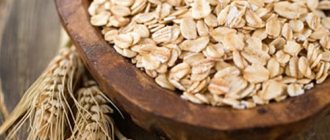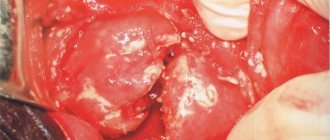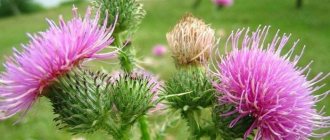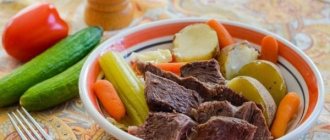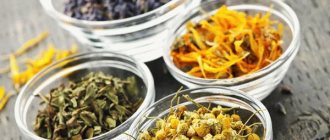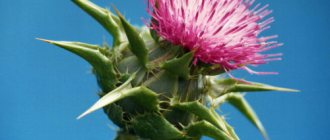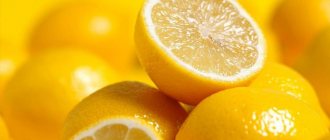The normal functioning of other organs and systems of our body largely depends on the health of the pancreas. Based on medicinal plants, products are prepared that improve its activity and restore damaged cells. For example, milk thistle for pancreatitis is an effective treatment that stops the inflammatory process and cleanses the ducts for the normal discharge of pancreatic juice into the small intestine. Another name for the plant is milk thistle.
The effects of milk thistle components on the body
Treatment of milk thistle liver and pancreas is based on the use of extract, meal, decoction and infusion of the plant, which are obtained by processing fresh raw materials.
The extract is prepared by evaporating and dissolving milk thistle powder in ethyl alcohol. Available in the form of capsules and tablets. Meal is a powder obtained from seeds. Milk thistle decoctions and infusions can be made from stems, leaves, and seeds not only in the laboratory, but also at home.
Based on the diagnosis, the doctor decides which of these remedies will be more effective. Milk thistle contains a very valuable substance - silymarin, which promotes the regeneration of liver cells (hepatocytes) and the normal secretion of pancreatic juice. In addition, it contains:
- vitamins of group B, as well as A, P, E, F, D, K, PP,
- trace elements and minerals: potassium, iron, magnesium, zinc, iron, bromine, iodine, chromium, manganese, lead, strontium, vanadium,
- tyramine and histamine are natural thyroid stimulants,
- food enzymes,
- flavonoids,
- fatty and essential oils,
- resin.
Milk thistle, which is considered a weed, has powerful medicinal properties.
Alcohol and water infusions based on it are widely used not only for the treatment of the pancreas, but also as a general tonic.
Milk thistle meal for pancreatitis
Meal is used for the chronic form of the disease, best during remission. Meal is a powder made from the dried seeds of a plant. Take it one tablespoon before meals. It is most effective to chew the powder and then drink plenty of water. Also added as a seasoning to food. There is no strict course of treatment - the meal is used for a long time.
milk thistle meal
Indications for use
Milk thistle is used for acute and chronic pancreatitis of the pancreas and other diseases of the internal organs:
- type 2 diabetes mellitus - a disease of the pancreas accompanied by insufficient insulin production,
- liver diseases characterized by chronic inflammation of tissues or their severe damage (cirrhosis, carcinoma, hepatitis),
- kidney pathology - during the period of exacerbation of the disease and with a sluggish form of pyelonephritis, glomerulopathy, tubulopathy,
- intestinal diseases - chronic constipation, hemorrhoids, ulcers,
- respiratory diseases - chronic bronchitis, tracheitis,
- joint diseases,
- vascular diseases,
- obesity 2 and 3 degrees.
Milk thistle in powder form can be added to tea and other drinks, and the oil can be used to season salads, stewed or baked vegetable dishes. The plant is safe for the body if there are no contraindications to its use. The course of treatment with milk thistle can last up to 1.5 months.
Contraindications
Milk thistle is a very powerful remedy, so it is used with caution. The plant is not recommended for use in the following cases:
- with cholecystitis in the acute stage,
- during pregnancy,
- for bronchial asthma,
- children under twelve years of age,
- people who are allergic to milk thistle.
Because of these features, doctors always recommend consulting with them whether it is possible to drink milk thistle in each individual case, because independent treatment can lead to an exacerbation of other diseases and a worsening of the situation.
Bibliography
- Minina S.A., Kaukhova I.E. Chemistry and technology of herbal remedies: textbook. 2nd ed., revised and expanded M.: GEOTAR-Media, 2009.
- Krepkova L.V. Experimental and clinical study of herbal remedies from milk thistle. Questions of biological, medical and pharmaceutical chemistry. 2008 No. 4 p. 306.
- Kurchenko V.P., Shchekatikhina A.S. Content of flavolignans of milk thistle in fruits and hepatoprotective drugs. Health of Ukraine 2011 No. 4 pp. 38-39.
- Krasnova Yu.V., Petushkova O.P., Kravchenko Yu.V. Antiatherosclerotic effect of a mixture of flax and milk thistle oils with selenopyran. News of PGPU 2007 No. 3 pp. 293–296.
Methods of application
Milk thistle has a mild, gentle effect. Therefore, the pancreas tolerates both milk thistle seed powder and plant oil, which envelops the gastric mucosa and eliminates belching and heartburn, which often accompany pancreatitis.
Traditional methods involve the use of homemade remedies and taking the extract in tablets and capsules.
Seed-based decoction
You can use this remedy, like others, after consulting a doctor. For preparation you will need:
- milk thistle seeds – 1 tbsp. l.,
- water – 1 glass.
Bring the water to a boil and pour it over the seeds. Close the container with a lid and leave for 2-3 hours. Then strain. Drink liquid in small portions - a quarter glass 2-3 times a day.
Seed oil
You can consume the plant in the form of ready-made oil by purchasing it at the pharmacy. It is easy to prepare medicine for pancreatitis at home. You will need:
- milk thistle seeds – 1 cup,
- olive (if you don’t have it, you can use flavourless sunflower oil) – 2 cups.
Pour oil over the seeds and leave to steep for 3 weeks. Then strain. Milk thistle oil for pancreatitis is used 1 teaspoon 30 minutes before meals.
Infusion of leaves and stems
Recipes for milk thistle infusion involve the use of different parts of the plant. To prepare the medicine, the roots of the plant and its above-ground part are used. A simple recipe that can be used for diseases of the gastrointestinal tract and pancreatitis:
- Chop milk thistle leaves and stems or use dry powder from them. You will need 1 tbsp. l. raw materials.
- Pour 1 cup of boiling water and leave for 1 hour.
- Strain and drink warm, a quarter glass 3 times a day.
The course of treatment with this medicine for pancreatitis is 0.5-1 month, followed by a break of 1-2 weeks.
Schrot
Meal is used for pancreatitis in different variations. It is added to drinks, yogurt, eaten as a powder and then washed down with liquid or consumed with vegetable dishes. For pancreatitis, meal is used according to the following scheme:
- Make a cup of green tea. Cool until warm.
- Eat 1 teaspoon of meal and drink it with tea. The liquid is drunk in small sips.
- The procedure is performed half an hour before meals.
Treatment lasts 40 days. You need to eat 4-5 tsp per day. meal
Extract
In laboratory conditions, an extract is obtained from milk thistle seeds, which is included in the tablets. They can be purchased at the pharmacy. Tablets weighing 0.25 g are taken for pancreatitis, 1 piece 1 time per day immediately before meals.
The course of treatment reaches 1-3 months - the period depends on the diagnosis and is adjusted by the attending physician depending on the manifested therapeutic effect.
Beneficial properties for illness
Milk thistle is a popular folk remedy that is used to treat diseases of the gastrointestinal tract. It contains many vitamins, minerals and other substances beneficial to humans, including iron, calcium, zinc, iodine, and potassium.
To improve the health of the pancreas, any form of the plant can be used - decoction, oil, meal. Milk thistle has a beneficial effect on the body, cleanses the pancreas of toxins and toxic substances, normalizes the production of enzymes and hormones, including insulin, thereby reducing the risk of developing diabetes.
Milk thistle has a beneficial effect on the body, thereby reducing the risk of developing diabetes.
Using it during the rehabilitation period after intensive therapy allows you to quickly restore the diseased organ, normalize the digestion process, strengthen the immune system and improve the patient’s condition. The herb stops the development of inflammation, preventing the formation of additional damage to the gland and restoring its functionality.
Milk Thistle Treatment Tips
Doctors recommend:
- Use milk thistle for pancreatitis with the permission of a specialist, because the product has a whole list of contraindications. Patients may develop individual intolerance to the components that make up the medicine.
- Be sure to pay attention to the expiration date if milk thistle is purchased at a pharmacy.
- This medicinal plant contains many enzymes and other active substances. Therefore, breaks should be taken between courses of treatment for pancreatitis so that the pancreas can independently cope with its functions.
- If necessary, there may be several courses of therapy - treatment is repeated if the symptoms of the disease have decreased, but still make themselves felt.
- You need to pay attention to the appearance and smell of plant materials. The seeds should not be stuck together and the plant should have a pleasant aroma. A musty smell indicates that the milk thistle is not fresh or has not been stored properly.
Types of medicinal plant
Gastroenterologists know for sure whether it is possible to drink milk thistle for pancreatitis. They claim that for pancreatitis it can be used not only during the period of remission (easing an exacerbation), but also when pain occurs. Immediately after consuming the plant, a period of prolonged remission begins, the duration of which depends on the adoption of therapeutic measures. The following medicinal plant variants are used to treat pancreatitis:
- Dried milk thistle seeds, the use of which involves preparing a decoction and powder.
- Milk thistle leaves and roots.
- Oil obtained by cold pressing.
Let's look at these dosage forms in more detail and find out what effects they can have.
Milk thistle powder
For chronic pancreatitis, milk thistle meal is used, which should be consumed strictly before meals. The decoction should be carefully filtered, and after drinking it, washed down with a large volume of water. This is done in order to speed up the process of assimilation of the healing components of the plant. The powder can be used not only to prepare a decoction, but also added to dishes, as well as brewed tea.
To prepare a decoction of thistle for pancreatitis of the pancreas, you will need to use 30 g of plant seeds. The seeds must be ground to flour, after which they are poured with boiling water in a volume of 0.5 liters. After this, the resulting mixture should be placed in a water bath and steamed until half of the water has evaporated. After this, the process of filtration and purification of the drink is carried out. You should drink it in the amount of 1-2 tablespoons before or after meals. You can continue the treatment course for up to 2 months.
Where, when and how to collect the plant
The plant can only be collected in places that are far from highways or industrial enterprises.
The timing of procurement of raw materials varies slightly:
- Seeds can be collected only after they are fully ripened. Typically this period begins in the second half of August and lasts until October. To determine the degree of ripeness, just look at the top of the basket. If there is fluff of a yellow-white hue, then the seeds are ready to be collected. Before the box opens on its own, it must be carefully cut off.
- Harvesting of roots is carried out in the fall, after the seeds have ripened and been collected or flown independently. The underground part of the grass is carefully dug up so as not to damage it, washed and dried.
- It is customary to collect leaves in the fall. Whole plates of greenery are cut or carefully torn off without damage.
After collection, all parts of the milk thistle are sent for drying.
When harvesting plant parts, it is important to follow some recommendations:
- Do not collect above-ground parts of thistles in conditions of high air humidity (in the morning before the dew disappears or after rain).
- You can only collect completely intact parts of the grass that have not been exposed to pests or diseases.
- It is necessary to strictly adhere to procurement deadlines.
To do this you need:
- The seed pods must be placed on a baking sheet, a sheet of cardboard and placed in a dry, well-ventilated area. The completely dry boxes are carefully opened, removing the seeds that still need to be dried, laid out in a thin layer on a sheet of cardboard.
- Before drying the roots of the plant, they need to be crushed. It is recommended to place it in the sun. It should heat a small layer of raw material located on a flat surface. To speed up the process, you can use an oven or a special dryer. At the same time, the temperature in them should not exceed 50 degrees. The readiness of the roots can be checked by bending them. If they are dry, they break easily.
- It is better to dry the leaves outdoors, protecting them from direct sunlight, or in a dry and well-ventilated area. To avoid the appearance of mold or mildew, you need to spread the greens in a thin layer. The leaves are stirred from time to time. Drying in the oven is also allowed, but it is important that the temperature is no higher than 40 degrees.
Store finished raw materials in paper or linen bags, as well as in glass containers that close well. The room should be cool, dry and dark.
Legends and written references to milk thistle
The first written mentions of thistle date back to the times of Ancient Greece. It is known that more than 2 thousand years ago, doctors used milk thistle to treat the same diseases that it successfully copes with in our time.
- stomach ulcer;
- diseases of the biliary system;
The physician Dioscorides, who lived about 2 thousand years ago, in his works described in detail the use of milk thistle decoction in the treatment of various types of poisoning. Scientists claim that the herb extract and powder from it are often found along with olive and rose oils during excavations of ancient Greek settlements.
In the Middle Ages, milk thistle was considered a gift from the Virgin Mary. According to legend, she gave people the seeds of the grass, as well as methods for treating it. To confirm the legend, they pointed to traces of white color. Milk thistle leaves are dotted with them. Believers perceived the marks as drops of Mary's breast milk.
There is another legend about milk thistle, according to which in the countryside there lived a poor man with numerous ailments. The man had no money and could not turn to doctors for help. In prayer, the patient turned to the Virgin Mary, who pointed him to a roadside thorn. The poor man began collecting milk thistle seeds every day and preparing medicine from them. A year later, the man was cured of all diseases.
Modern doctors have not lost sight of the healing properties of milk thistle. In almost every medical reference book you can find a detailed description of the plant and medicinal products based on it.
Pharmacists paid attention to milk thistle in the mid-20th century, beginning to use it to treat a number of diseases.
Description of milk thistle and habitat
Milk thistle, or as it is also called thistle, is a one- or two-year-old herbaceous plant belonging to the Asteraceae family. The grass grows up to 1.5-2 meters in height. Milk thistle can grow up to 100 centimeters in width.
The main characteristics of the plant are as follows:
- The stem is covered with a powdery coating. Most often it is straight, but sometimes it can branch.
- The leaves are predominantly large in size, pinnate with spiny-toothed blades, and colored light green or bright green.
- The flowers of the plant are tubular, similar in appearance to a basket, about 6 centimeters wide. The buds are colored crimson or lilac. On the outside, the flowers are protected in the form of sharp spines located on the corolla with leaves.
- Thistle fruits or seeds may be grey, brown or black in color. The grains taste bitter. Each seed after ripening has a long hairy tuft.
The homeland of milk thistle is considered to be the Mediterranean, from where milk thistle spread to a large part of Europe, America and Africa. Due to its unpretentiousness, thistle is able to grow at high temperatures, prolonged absence of moisture or, conversely, in cold and shade.
The plant quickly invades new habitats, therefore it is recognized as one of the harmful weeds. Milk thistle is grown on an industrial scale in many European countries for the purpose of preparing medicinal raw materials.
Herbal medicine for diseases of the stomach and intestines
Herbal medicine has been used in the treatment of diseases of the digestive system since ancient times. The use of herbal remedies helps enhance the effect of medications, reduce the severity of symptoms, and accelerate recovery. Herbal medicine is a recognized method of complex treatment of the gastrointestinal tract.
For chronic gastritis, peptic ulcers, especially with low acidity, and diarrhea, preparations from calamus rhizomes, for example, infusion, are used. Calamus rhizome powder is included in medications such as Vikalin and Vikair, prescribed for gastric and duodenal ulcers. Calamus preparations can be used for cholecystitis and hepatitis.
For gastritis, peptic ulcers, enterocolitis, cholecystitis, pancreatitis, plantain juice, chamomile, caraway seeds, and yarrow are used. These plants have an anti-inflammatory effect and normalize the motility of the stomach and intestines.
How to use correctly
To get the maximum effect from the plant in the correction of pancreatitis, you will need to learn how to use it correctly. Milk thistle is used alone or with other plants. It should be noted that the components of the collection must be compatible with each other so that the medicine does not cause health problems.
You can prepare a decoction of milk thistle for the pancreas from any part of the plant. The roots are added to salads, soups or meat dishes.
Meal is often used to treat pancreatitis. Take before meals, chew thoroughly and drink water. Meal can be added as a seasoning to various dishes.
To prepare the decoction you will need:
- Take well-dried roots and leaves and pour boiling water over them.
- Leave to infuse for 12 hours.
- Strain.
You should drink the product three times a day before meals, a third of a glass.
Pharmacies sell ready-made mixtures or milk thistle separately for the treatment of pancreatitis. The course of treatment should last 1 – 2 months until improvements appear. Then there is a short break for several weeks.
The plant is used to prevent exacerbations and complications of pancreatitis. Such therapy should last a month, then a break is taken for a month.
What is cholecystitis and why does it develop?
Cholecystitis is an inflammation of the gallbladder. Most often, this disease is a complication of gallstone disease. Why is it developing?
Doctors consider the main cause of the development of the disease to be the presence of bacteria or parasites in the body (Escherichia coli, staphylococcus, etc.).
The disease can be successfully treated, but stones in the gall bladder can complicate the treatment process. Reduce inflammation, prevent the appearance of new stones and begin to slowly destroy old ones; milk thistle is capable of all this.
Pharmacological preparations with milk thistle extract
In the pharmacy you can find a wide selection of pharmacological preparations that contain milk thistle extract.
The most popular of them are:
Before taking any medication, you should consult your doctor, as there are contraindications. For example, the components of milk thistle and gallstones are incompatible. Due to the powerful choleretic effect, stones can enter the bile duct and lead to its blockage. This condition requires immediate surgical intervention.
How milk thistle fights cholecystitis
I foresee the cries of skeptics, but milk thistle is really capable of fighting this disease and fighting it quite effectively! I'll try to explain why.
It has been established and scientifically proven that milk thistle:
- can relieve inflammation (and cholecystitis is a disease of an inflammatory nature)
- improve the formation and discharge of bile
- eliminate spasms of the gallbladder and biliary tract
- effectively fight germs and bacteria that cause disease
- destroy gallstones
- prevent the formation of new gallstones
And one more thing, silymarin contained in milk thistle is a unique complex of antioxidants that strengthens liver cells, protects them from the effects of toxins, free radicals and alcohol.
In addition, silymarin stops the inflammatory process, normalizes bile production, cleanses the blood and improves metabolism. So, whatever one may say, milk thistle is useful, including for cholecystitis! And it would be absolute stupidity not to take advantage of this simple thing. affordable and completely natural remedy.


